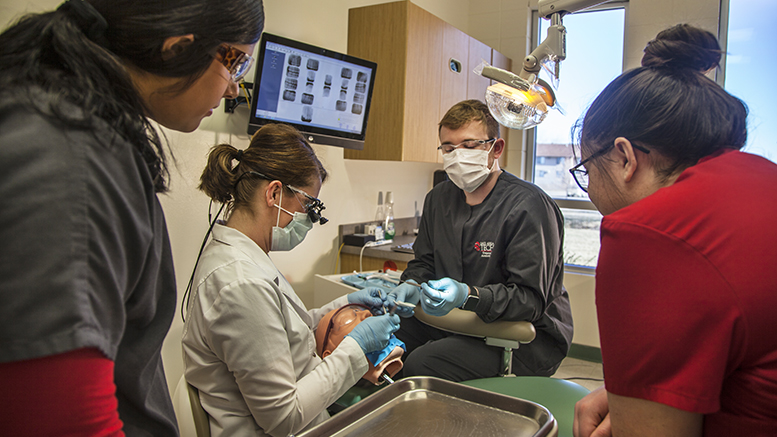Employment of dental assistants and hygienists is projected to balloon 20 percent over the next decade, a trend the Bureau of Labor Statistics attributes to an aging population coupled with research connecting oral health to overall health.
Community colleges are staying abreast of this growing movement via programming for both the front and back of the office, whether its cleaning teeth, taking X-rays or scheduling appointments. Dental accreditations and degrees are currently available at two-year colleges nationwide — including the farthest reaches of Alaska — pointing to an industry very much in demand.
“There’s a combination of factors (regarding industry growth), insofar as more people have dental insurance and are seeking care,” says Phyllis Spragge, director of dental hygiene at Foothill College. “And there’s lots of evidence linking dental disease and systemic diseases.”
This excerpt comes from an article in the current issue of the Community College Journal, published by the American Association of Community Colleges.
An established program
Located in Los Altos Hills, California, Foothill offers learners a dental assisting and dental hygienist degree program. Participants on the hygiene track study toward a four-year bachelor of science degree consisting of 196 credits, requiring completion of two years of prerequisites followed by two years of dental hygiene core courses. The program — accredited by the Commission on Dental Accreditation (CODA) — also prepares graduates for state and regional board exams and licensure.
Launched in 1964, the hygiene program graduates 24 students annually and has a 95 percent retention rate. Clinical skills gained through the degree include anesthesia, plaque removal and use of X-ray machines.
In high-cost California, full-time dental hygienists can make upwards of $100,000 a year, nor is cleaning and X-raying teeth their only career options. Some Foothill grads make six figures as corporate education representatives, demonstrating products or oral care procedures for offices and dental associations.
Keeping up with technology
Foothill’s 10-month dental assisting program provides academic, laboratory and clinical courses, resulting in an associate degree that students can use for a dentist’s office position as well as specialties like endodontics (dealing with soft inner tissue of the teeth) or oral surgery.
Department Chair Cara Miyasaki says advances in technology have increased the demand for qualified dental assistants. 3D printers and digital scanners create detailed dental crowns or implants, while digital X-rays are replacing traditional photographic X-ray film with enhanced computer images.
Foothill carries equipment found in most modern dentist’s offices, funded by U.S. Department of Education technical grants, district bond funds and dollars from the California-based Strong Workforce Program.
“There’s a need for basic services and there are people in Silicon Valley who want high-tech services for milled crowns,” Miyasaki says. “Dentists are going to want assistants with training.”
An array of career options
Lake Area Technical Institute (LATI) in South Dakota has two-degree options for its certified dental assisting program: a 43-credit diploma program and a 68-credit associate degree, both of which blend distance and on-campus learning. LATI’s requirements include 300 hours of clinical experience in a school-approved dental office.
LATI’s e-degree is designed for part-time students, allowing participants to earn a diploma in four semesters and an associate of applied sciences (AAS) degree in six semesters. When finished, new dental assistants are prepared to polish teeth, take X-rays and sterilize equipment, ideally cultivating an expanding skillset to make a dentist’s life easier.
A CODA-accredited curriculum draws 45 to 50 students annually, says Nicole Pahl, head of LATI’s dental assisting program. Alongside digital X-rays and composite fillings, the program introduces students to cutting-edge software applications enabling providers to manage all aspects of a practice, from check-ins to appointment reminders to digital record transfers.
“Every time something new goes to market, we try and get our hands on it so students can jump right in and use it,” Pahl says. “They should feel comfortable working in the front and back of the office.”
LATI also has a partnership with the University of South Dakota, where students can roll credits from their AAS into hygiene or dental health administration. Completion of a health science degree, for example, could net them a managerial position at a dentist’s office.
“It’s endless what students can do with this degree,” says Pahl. “They can keep moving up.”

